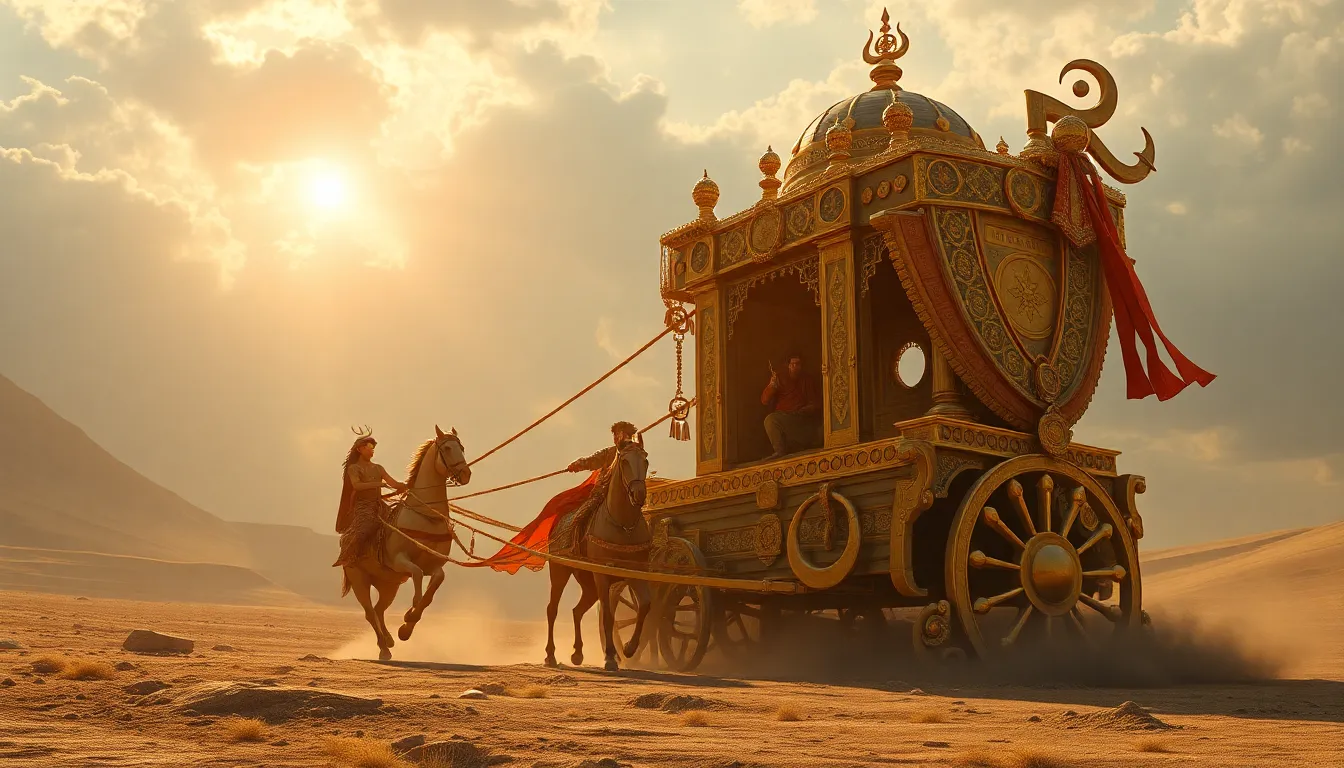The Golden Chariot: Myths of the Sun God’s Journey
I. Introduction
The Sun God is a prominent figure in numerous mythologies around the world, symbolizing light, life, and divinity. From the blazing heat of the Egyptian Ra to the radiant Helios of Greek mythology, these deities have captured the imagination of ancient civilizations. Central to many of these myths is the concept of the golden chariot, a celestial vehicle that embodies the Sun God’s journey across the sky.
This article aims to explore the various myths surrounding the Sun God’s journey, delving into the significance of the golden chariot and its representation in different cultures.
II. The Sun God Across Cultures
Different cultures have worshipped their own versions of the Sun God, each with unique attributes and symbolism. Some notable Sun Gods include:
- Ra – The Egyptian Sun God, often depicted as a falcon-headed deity who travels across the sky in a solar boat.
- Helios – The Greek personification of the sun, depicted as driving a chariot drawn by fiery steeds.
- Surya – The Hindu Sun God, who rides a chariot pulled by seven horses.
The significance of the sun in these ancient civilizations cannot be overstated. It was often linked to concepts of time, fertility, and the cycle of life. Common themes associated with Sun Gods include:
- Light and enlightenment
- Life and fertility
- Justice and order
III. The Golden Chariot: Symbolism and Significance
The golden chariot is a powerful symbol in many mythologies, representing the Sun God’s journey across the heavens. In various traditions, the chariot is described as:
- Adorned with gold and precious gems, symbolizing wealth and divinity.
- Drawn by mythical creatures, such as horses or chimeras, signifying strength and speed.
Gold, in ancient cultures, often represented the divine, purity, and immortality. The chariot itself symbolizes the means of transition between realms, allowing the Sun God to traverse the sky and illuminate the world below.
IV. Creation Myths and the Origin of the Sun Chariot
Creation myths often provide insight into how the golden chariot came to be. Various cultures have their own theories, such as:
- The chariot was forged by divine blacksmiths, using celestial materials.
- It was a gift from other gods, symbolizing the Sun God’s importance among deities.
For instance, in Hindu mythology, Surya’s chariot is said to have been created by Vishwakarma, the divine architect. Creation stories often feature the Sun God in pivotal roles, showcasing their power and influence over the natural world.
While the basic premise of a golden chariot remains similar across cultures, variations in mythological narratives highlight the unique aspects of each civilization’s beliefs.
V. The Journey of the Sun God
The journey of the Sun God is a daily cycle, where he rises in the east and sets in the west. This journey is fraught with mythical obstacles, including:
- Monsters that threaten to extinguish his light.
- Darkness that seeks to engulf the land.
For agricultural societies, the significance of this journey is profound. The Sun God’s movement across the sky directly influences the cycles of planting and harvesting, embodying the relationship between the sun and the fertility of the earth.
VI. Associated Deities and Figures
The Sun God is often accompanied by other deities who assist in his journey. Key figures include:
- Chandra – The lunar deity in Hindu mythology, representing the balance between day and night.
- Selene – The Greek goddess of the moon, often depicted alongside Helios.
These relationships illustrate the interconnectedness of solar and lunar deities, emphasizing the duality of light and darkness in mythology.
VII. The Golden Chariot in Art and Literature
Throughout history, the golden chariot has been a subject of fascination in art and literature. Ancient art often depicts the Sun God riding in a chariot, showcasing:
- Vibrant frescoes and murals in temples and tombs.
- Statues and carvings that celebrate the power of the Sun God.
Literary references to the golden chariot can be found in texts such as the “Mahabharata” and various Greek epics, where the imagery of the chariot symbolizes divine power and the daily renewal of life. In modern interpretations, these myths continue to inspire artists and writers, reflecting humanity’s enduring fascination with the sun and its deities.
VIII. The Golden Chariot in Rituals and Festivals
Cultural celebrations honoring the Sun God often feature rituals involving representations of the golden chariot. These may include:
- Processions during solstices and equinoxes.
- Festivals that celebrate the harvest and the life-giving power of the sun.
Such traditions have influenced contemporary practices, where many cultures still honor the sun through rituals and celebrations, reflecting the enduring legacy of the Sun God in human society.
IX. Comparative Mythology: The Golden Chariot Across Civilizations
When examining the golden chariot myths globally, similarities and differences emerge. Some notable points include:
- Many cultures depict the Sun God as a powerful figure who traverses the sky in a chariot.
- Differences often arise in the specific creatures that pull the chariot and the challenges faced during the journey.
The influence of geography and culture is evident in how these myths developed, providing a fascinating glimpse into the human experience and our relationship with the sun. Universal themes, such as the cycle of life and the battle between light and darkness, resonate across cultures, highlighting the central role of the Sun God in mythology.
X. Conclusion
In conclusion, the golden chariot is a rich symbol in the mythology surrounding the Sun God, representing the divine journey across the sky. Through various cultures, we see common themes of light, life, and the cyclical nature of existence. The myths not only illustrate the importance of the sun in ancient civilizations but also reflect the timeless human quest for understanding the natural world and our place within it. The legacy of the Sun God and his golden chariot continues to inspire and captivate, reminding us of the enduring power of nature and the divine.


